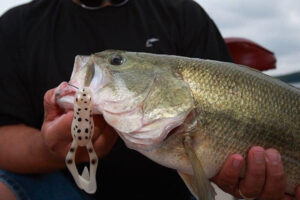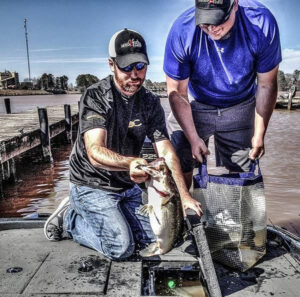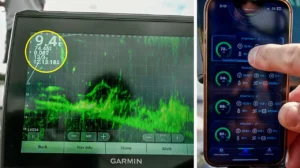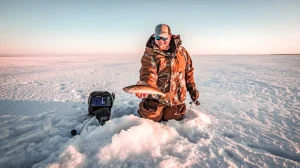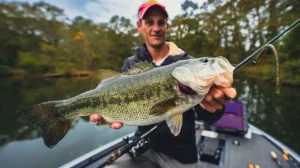Whether you’re looking to make a little extra spending money or simply have a good time with an old fishing buddy, team bass tournaments give you that opportunity. But let’s be real here, folks—bass anglers are a competitive bunch and it sure makes the day better when you’re putting giant bass in the boat.
I’ve been fishing team tournaments since my teenage years and have been fortunate enough to enjoy some success along the way. Over time, there have been 10 major factors that have allowed my partners and me to catch more bass and most importantly, have a lot more fun in the process.
1. Target different parts of the water column
One of the quickest ways to end up frustrated during a team tournament is by targeting the same water column as your partner. Now if one of you starts whacking ‘em at a very specific depth, that’s a different story that we’ll cover in a second. But whether you’re fishing from the front or the back of the boat, never underestimate the power of differentiation and experimentation.
For example, most team tournament trails get pretty hot and heavy starting in the spring. What are the majority of anglers going to do first thing in the morning? Throw a topwater lure. There’s nothing wrong with it—giant bass eat topwaters—but let one person take care of it. To increase your team’s chances of finding a secondary or even an overlooked primary pattern, one of you should make an effort to find some sort of subsurface bite with something like a soft jerkbait, wakebait or a floating worm.
The same theory applies to deeper sections of the water column as well. If your buddy is throwing a five to seven-foot running crankbait, try to expand the pattern by tossing a crankbait that runs a little shallower or deeper—heck, maybe even make a few casts with a suspending jerkbait. Even if your partner is out-catching you, don’t let it bother you—it’s funny how the partner who doesn’t catch quantity often ends up catching the kicker fish.
2. Utilize different profiles
After you and your partner have targeted different depth zones throughout the morning, it’s likely you’ll zone in on the most productive depths within a few hours. When this happens, avoid the temptation to throw the exact same thing as your buddy. Instead, target the same depth but throw the bass a curveball.
It can certainly happen, but very rarely will you catch a big bass casting the same bait into the same area your partner has already saturated. These big bass don’t get old by being stupid—they’ve seen hundreds of artificial baits throughout their lives and if they don’t bite the first time, they usually won’t bite the second time.
Using a different profile than your partner will also give you the opportunity to further concentrate your pattern. If your buddy is catching 10 fish to your one fish, that’s when you need to consider matching their bait’s profile.
Although things can change depending upon fishing pressure, weather conditions and the mood of the bass, here is a more specific outline of my thought process. These are a few of my favorite combinations, but the possibilities are endless.
Partner throwing a walking topwater—try a topwater popper, soft jerkbait, floating worm or a topwater frog.
Partner throwing a Texas rig—try a jig, shaky head or Carolina rig.
Partner throwing a wide-bodied crankbait—try a flat-sided crankbait, jerkbait or soft jerkbait.
Partner throwing a spinnerbait—try an inline spinner, underspin or small swimbait.
3. Both anglers should watch the electronics
If you’re a boat owner with electronics, chances are you have a decent understanding when it comes to interpreting your graphs. If your partner is inexperienced with electronics, don’t worry. Try to take some time before blast-off or during your practice day to educate them on the essentials. I’m not necessarily talking about a day-long, extensive training course. It won’t take them long to pick up on the simple cues to look for and as the old saying goes—two heads are better than one.
If you’re anything like me, you can get really dialed-in when you’re fishing and tend to overlook small signs or telling environmental cues throughout the day. If your partner can understand your electronics and help you keep an eye on things, both of you will have a much better chance of dissecting the fishery on any given day.
These are some of the things I believe both anglers need to understand when it comes to electronics.
Contour lines—paying close attention to contour lines throughout the fishing day can pay huge dividends in tournaments. Make sure your partner knows the indications of steep drop-offs, channel swings and flats.
Water temperature—sometimes just a single degree of difference in water temperature can make the difference between catching a giant sack or a limit of pecker snots—my affectionate term for 12-inchers. It’s good practice for both anglers to pay attention to small changes in temperature as it can change from creek-to-creek or short pocket-to-short pocket.
Bait—wherever you find large concentrations of bait, you’re probably going to find some bass in the mix. Teach your partner how your electronics indicate bait and they may tip you off to some bonus schoolers.
4. If available, practice in separate boats
Everyone fishes differently, so it’s a good idea for you and your partner to practice in your own boats. Sure, you won’t be able to split gas money or joke around on these days, but there are some definite advantages to it.
Quick tip: If you’re able to practice in two boats, try going to a totally different area of the lake than your partner. The bass may be doing something completely different, which can result in a great backup plan.
When you’re in your own boat, it’s a lot easier to experiment with things. You have all your soft plastic colors, hard baits and fishing rods and know where to find them, which makes you less resistant to change. I do it all the time when I’m fun fishing from a friend’s boat—I’d love to change to a different color, but is it really worth digging through their stuff for 15 minutes to find what you’re looking for? My answer is usually “no”, but if I were in my boat, I’d find my desired color and be ready to roll in under a minute.
Practicing in separate boats also drastically increases the amount of water you’re able to cover in a given day. Very few of us are able to fish whenever we want to due to work or family obligations, so we’re often left with a single day—or maybe just a few hours if we’re lucky—to practice for Saturday’s derby. By having two boats performing a little recon, you’ll be able to sit down to dinner and a beer on Friday night, compare notes and develop a legit game plan.
5. If you practice together, net your fish
If I had a nickel for each netting mishap that’s blamed of losing a buddy tournament, I’d be one rich, ugly redneck. Joking aside, you’re flirting with potential disaster every time your partner jabs the next toward a tournament-winning fish. To increase your bite-to-livewell ratio, break out the net during practice.
It’s so important that you and your tournament partner have a solid netting system in place—you have to “jive”. With nothing but a few hooks and some line between you and a nice payday, the net man’s job is critical. It’s not ideal to go stick a bunch of nice bass the day before a tournament, but in the event that someone hangs one, use the opportunity to practice your netting skills.
In my experience, my partners and I have had our best luck employing a simple netting practice. When you stick a fish, you need to tell your partner immediately. Don’t waste time estimating its size or replaying the bite. Save that for when the fish is in the livewell. As your partner is fighting the fish, go ahead and get the net in the water at the side of the boat and whatever you do, don’t stab at the fish. It will spook it, causing it to surge to deeper water, drastically increasing the chances of it coming unbuttoned. With the net in the water, slowly play the fish out until you can easily direct him into the net.
Try not to lose concentration once the fish gets in the net. Lift it up and place the net in the floor of your boat—never on the front or back deck. If the fish flops out of the net while in the bottom of your boat, you won’t have to worry about it going overboard.
6. Alternate trolling motor operation between fish catches
You never know until it happens, but sometimes a single fish catch can ignite an entire school into an absolute feeding frenzy. If your partner is in the floor of the boat trying to untangle their crankbait from the next or the bass’ mouth, jump on the trolling motor and pick up where they left off. You want to capitalize on the opportunity by getting your bait in the strike zone as soon as humanly possible.
Let ’em practice with it: If your partner is unfamiliar with your trolling motor, let them use it in practice if possible. This aids in seemless operation and nobody will get tossed overboard from an unfortunate mistake.
This also helps when your partner is re-rigging, re-tying or fumbling through the compartments looking for a specific bait. Taking control of the trolling motor will help you keep the boat in prime position, maximize fishing time and avoid spooking wary, shallow bass.
7. Both anglers should know how to operate the livewells
It’d be nice if we all had high-end boats with livewell controls on the bow, but that’s not the case. We’re bass anglers, so we make do with what he have. My boat’s livewells are controlled from the console, so I make certain to teach my partners how to correctly operate them.
Fish care is my ultimate priority on the water, so to say I’m anal about it would be a drastic understatement. Instead of jumping all around the boat, constantly tinkering with livewell switches and knobs, ask your partner to help.
Whether I’m in the back of a friend’s boat or in the front of mine during a tournament, the system holds true—whoever is in the back needs to keep an eye on the fish. Every 10 or 15 minutes, take a quick peek at the fish, make sure they’re upright and kickin’, pump some fresh water in and make sure the recirculation pumps are running correctly. It only takes a few seconds and it also cuts down on boat noise because you’re not stomping around like a mule going back and forth between your bow and the console.
8. Keep a follow-up bait unclipped and ready
Missed fish are bound to happen, but that doesn’t mean you can’t make them bite again. Whether you’re in the front or the back of the boat, watch for any swing-and-misses by your partner. Before they have a chance to reel their bait back to the boat, you need to have a bait in the same exact area.
For my follow-up bait selection, I like to have a weightless stick worm and a 1/2-ounce jig on standby at all times. They’re not clipped to my reels or line guides or stuffed inside my rod lockers—they’re usually hanging over the side of the boat at all times. If I hear the unmistakable “whiff” of a partner or vice versa, a bait needs to be put in front of the same fish without hesitation.
It takes some practice and the right mindset, but try not to let it bother you when your partner immediately pitches to an area in which you missed a fish. Remember, it’s a team tournament so it doesn’t matter who catches the fish—getting it in the livewell is what’s important.
9. Devise a plan for dividing costs and earnings before the tournament
Before you even back the boat into the water, make a fair plan regarding any incurred costs or earnings for the tournament. I’ve seen this breakup a lot of powerful fishing teams—any time there’s money involved, make an effort to get it all figured out before the tournament.
Each team is different and that’s totally cool. Some teams let the angler who caught the big fish keep the big fish pot, some teams split it all down the middle. Either way is fine, but just make your expectations clear before any cash starts getting tossed around. In my experience, splitting everything—boat gas, truck fuel and winnings—down the middle is the easiest way to do things. This will avoid anything coming between you and your best fishing buddy.
10. Keep things loose
This is the most important part of this entire article. There’s nothing wrong with embracing the competition of tournament fishing, but be careful not to get carried away with it. You never want to lose a good fishing friend because you take things too seriously. It’s just a buddy tournament—not the Bassmaster Classic—so do your best to relax throughout the day. You’re off work, you’re healthy and you’re spending the day doing what you love. There’s no reason to be uptight, so try to smile and cut up a little bit. In the big scheme of things, does it really matter if you don’t catch a limit?
Try to remember: It’s just fishing, so whether you catch 25 pounds or 6 pounds, try to smile, laugh and have a great time. We’re all blessed to have such an awesome hobby.
Small things like a misplaced cast, a brush pile snag or an inconvenient backlash are going to happen throughout the day. They may not show it on television, but it even happens to the best professionals in the world. Give each other a hard time about it, fastball a Gatorade at their gut when they ask for a drink or bump their rod butt to make them think they have a bite. Just do something to keep the mood light and morale up.
Team bass tournaments are a great way to spend a Saturday. Beautiful scenery, good fellowship and a fishing rod in-hand are all the makings for some unforgettable memories. If you can practice these 10 tips, I believe you’ll catch a lot more bass, but most importantly, have a lot more fun along the way.



